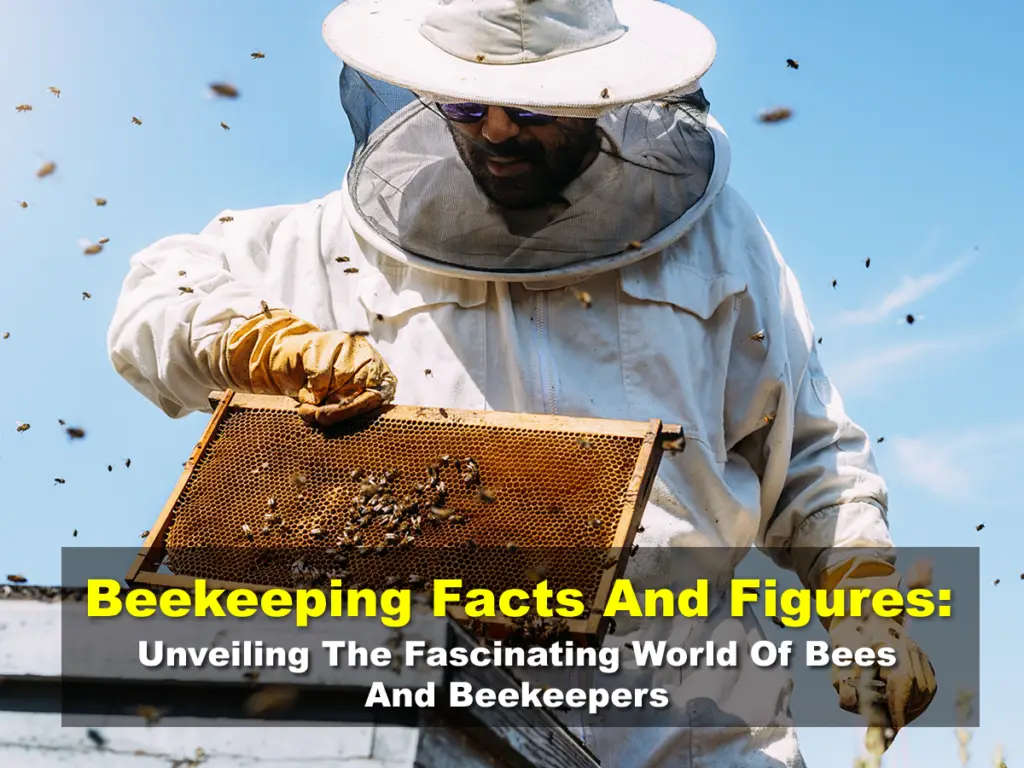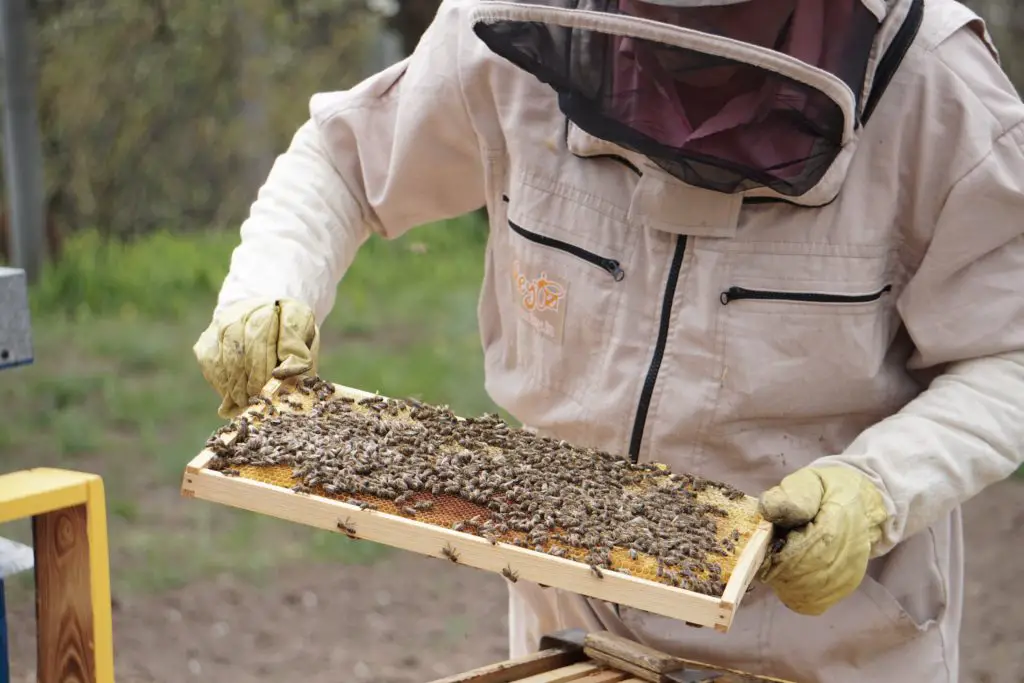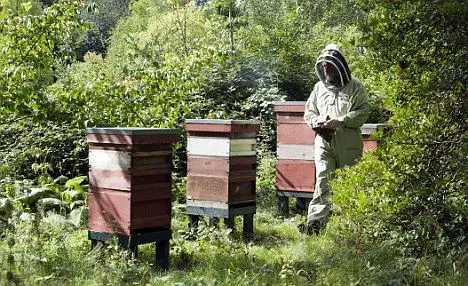Affiliate Disclaimer - As an Amazon Associate I earn from qualifying purchases.
It supports the website. So, Thank you
Have you ever wondered about the buzzing world of bees and their dedicated keepers? The practice of beekeeping has been around for over 4,500 years, providing incredible benefits to our planet.
This article delves into the intriguing facts and figures about bees and beekeepers, shedding light on their roles in pollination, agriculture, economy, as well as the threats they face. Get ready to embark on an eye-opening journey into this vital but often overlooked aspect of our global ecosystem!
Table of Contents
Key Takeaways
- Beekeeping has a rich history spanning over 4,500 years and is integral to ancient civilizations, highlighting the significance of bees in human culture.
- Bees have complex anatomy and behaviors, including intricate communication skills within their hive community and roles as queens, workers, or drones.
- Bees play a vital role in pollination and agriculture by cross-pollinating flowers and contributing to the growth of crops. About one-third of food consumed can be traced back to honey bee pollination.
History and Importance of Beekeeping
The art of beekeeping boasts a rich tapestry woven through over 4,500 years of human history. From historical records, it’s evident this practice was integral to ancient civilizations such as the Egyptians who saw bees and honeycomb as potent symbols of royalty and power, underlining their vibrant cultural heritage.
These early beekeepers understood even then the significance of these industrious insects in their everyday life.
In more modern times, the importance of beekeeping has only heightened given the pivotal role bees play in agriculture through pollination. Roughly one-third of all food consumed can be traced back to honey bee pollination – a fact that emphasizes not just their ecological contribution but also our deep-seated reliance on them for sustenance.
The evolution from primitive hive models to Langstroth’s movable frame iteration marks significant strides within American Beekeeping history, further highlighting its enduring relevance across centuries.
Fascinating Facts about Bees
Bees have a complex anatomy and lifecycle, with each bee having distinct roles as either a queen, worker, or drone.
Bee Anatomy and Lifecycle
Understanding the anatomy of bees is crucial to grasping beekeeping facts and figures. Bees boast a complex yet efficient biological structure that assists them in their daily activities. They have three distinct body parts: the head, thorax, and abdomen.
Equipped with compound eyes for better vision, an antenna for sensing smell and wind direction, as well as mandibles for feeding on nectar from flowers.
The life cycle of a bee comprises four stages – the egg, larva, pupa and adult stage. Once laid by a queen bee with precision inside hexagonal cells within a beehive’s honeycomb structure, these eggs hatch into larvae after about three days.
These larvae feed on royal jelly initially then switch to pollen-nectar mix (bee bread). After several moltings over about 5-6 days – depending upon whether they’ll become worker bees or drone bees – they metamorphose into pupae post-cell-capping by worker bees safeguarding them during this critical transformation phase within cocoons spun around themselves.
Emerging out as adults after 7-14 days approximately (again depending upon caste), these fascinating creatures are ready to fulfill their assigned roles amidst social stratification existing within beehives.
Bee Behaviors
Despite their tiny size, bees demonstrate a myriad of complex behaviors that intrigue both scientists and beekeepers. Central to these behaviors are the exceptional communication skills they exhibit within their hive community.
Bees employ dance – primarily ‘waggle’ and ’round’ dances- as an ingenious way to communicate precise information about food sources to their fellow bees. Notably, honeybees can fly up to five miles for food; however, they are smart navigators who use the sun as a compass while remembering landmarks in order not to get lost during their flower visits which range between 50-100 per trip! Nightfall or bad weather sees them retreat back into the safety of their hives where temperature regulation kicks in – another testament to Bee Behaviors.
The worker bees fan their wings at speeds of around 200 beats per second generating air conditioning effects that maintain optimal temperature for larval development and honey production. Such intricate interspecies interactions coupled with advanced communal coordination make the study of bee behavior an enchanting aspect of understanding our ecosystem better.
Queen Bees
Queen bees are the backbone of a bee colony, responsible for its organization and survival. These fascinating creatures play a crucial role in regulating the hive’s population by laying eggs and maintaining order among the worker bees.
Unlike their male counterparts, queen bees can sting multiple times without dying, making them formidable protectors of the colony. Their lives are far from royal, as they face unique challenges and responsibilities that ensure the colony’s prosperity.
With their sophisticated behaviors and vital contributions to bee society, queen bees truly reign supreme in the mesmerizing world of honeybees.
Worker Bees
Worker bees are the backbone of a beehive, tirelessly performing various tasks to ensure its smooth operation. These female bees make up the majority of the hive’s population and take on multiple roles throughout their short but busy lives.
From cleaning and maintaining the hive to foraging for nectar and pollen, worker bees are responsible for keeping the colony thriving. They also nurse and feed the developing brood, regulate the temperature within the hive, and even defend it against intruders.
With a lifespan of only a few weeks during summer months, these incredible creatures work ceaselessly towards ensuring the survival and prosperity of their hive.
Drone Bees
Drone bees are an integral part of the bee colony, playing a unique role in the fascinating world of bees. Unlike their worker bee counterparts, drones do not have stingers, making them unable to defend the hive or themselves.
However, this doesn’t stop them from contributing to the survival and growth of the colony.
The main purpose of drone bees is reproduction. Their larger eyes allow them to spot potential queen mates while in flight. In fact, drones mate with the queen bee mid-air – an impressive feat that showcases their agility and precision.
But here’s an interesting fact: after mating with a queen bee, drones meet their untimely demise as they lose their genitals during copulation.
Among other intriguing details about drone bees is their need for nourishment from nurse workers within the hive. As male bees, they don’t collect pollen or honey as worker bees do; instead, they rely on dedicated nurses to feed them until mating time arrives.
Native Bees
Native bees are an integral part of the diverse world of pollinators, which encompasses over 200,000 species. These bees, along with birds, butterflies, bats, beetles, and flies contribute to the crucial process of plant reproduction through pollination.
Unlike their more commonly known counterparts like honey bees, native bees encompass a wide range of species that vary in size and appearance. They have adapted to specific regions and ecosystems over time and play a significant role in maintaining healthy ecosystems.
Native bees are vital for the successful reproduction of many plant species and promote biodiversity by ensuring the survival of both wildflowers and crops alike. Their contribution to pollination is invaluable in sustaining not just our natural environment but also our food production systems.
The Role of Bees in Pollination and Agriculture
Bees play a vital role in the process of pollination, which is crucial for agriculture and food production. When bees visit flowers to collect nectar and pollen, they inadvertently transfer pollen from the male parts of one flower to the female parts of another.
This cross-pollination helps plants reproduce and produce fruits, nuts, and vegetables. In fact, bees are responsible for pollinating about 75% of the crops grown in the United States alone.
The impact of bee pollination on agriculture is significant. Honeybees alone contribute around $15 billion worth of crop pollination each year in the US. This includes more than 130 types of crops such as apples, cranberries, melons, broccoli, almonds – which rely entirely on bee pollination for their growth – and many more.
Additionally, bees play a crucial role in pollinating various fruits like strawberries and blueberries that are not only delicious but also packed with essential nutrients.
Without bees as effective pollinators, our food supply would be severely affected. Bee-friendly practices such as protecting natural habitats rich in flowering plants can help support healthy populations of these important insects and safeguard our agricultural systems for generations to come.
Threats and Challenges to Beekeeping
- Varroa Mites: The oldest and biggest threat to beekeeping, these parasitic mites feed on honey bees and weaken their immune systems, making them more susceptible to diseases.
- Pests and Predators: Besides Varroa Mites, bees also face threats from other pests and predators like small hive beetles, wax moths, ants, birds, and bears.
- Pesticides and Chemicals: The use of pesticides and chemicals in agriculture can have detrimental effects on bee colonies. Bees are exposed to these toxic substances when they forage on crops treated with pesticides.
- Habitat Loss: The destruction and fragmentation of natural habitats due to urbanization, deforestation, and monoculture farming reduce the availability of food sources for bees. This loss of diverse flora negatively impacts their nutrition and overall health.
- Climate Change: Bees are highly sensitive to changes in temperature and weather patterns. Climate change can disrupt the timing of blooming seasons, causing a mismatch between flower availability and bee activity. It can also lead to extreme weather events that directly impact bee colonies.
Honey and Other Bee Products
Honey bees are exceptional creatures not only for their pollination services but also for the range of beneficial products they produce. In the world of beekeeping, these products are highly valued for their numerous uses and health benefits.
| Product | Description |
|---|---|
| Honey | A sweet, viscous substance produced by bees from the nectar of flowers. Honey bees visit 50-100 flowers in one trip to collect nectar. The making of a pound of honey requires 2 million flower visits, with bees flying 55,000 miles. Honey is known for its nutritional value, medicinal properties, and delightful taste. |
| Beeswax | A natural wax produced by honey bees. These remarkable creatures use it to build honeycomb cells where honey and pollen are stored, and larvae grow. Beeswax is widely used in cosmetics, skincare products, and candle-making due to its natural composition. |
| Pollen | Collected by bees from flowers, pollen forms an essential part of a bee’s diet. As well as being a vital protein source for the hive, it is also consumed by humans as a health supplement due to its rich protein, vitamins, and minerals content. |
| Royal Jelly | A secretion used to feed larvae and adult queen bees. It’s sought after for its supposed health-boosting properties. |
| Propolis | A resin-like material gathered by bees from tree buds. Bees use propolis to seal gaps in the hive, but it’s also prized by humans for its potential health benefits. |
These bee products not only support the survival and health of the hive but also offer wide-ranging benefits and uses for humans, enhancing the value and importance of honey bees in our society and economy.
The Impact of Beekeeping on the Economy
The economy significantly benefits from beekeeping and the all-important role bees play in global agriculture. The economic value that bees, through the practice of beekeeping, bring to the table cannot be overstated.
| Aspect | Description |
|---|---|
| Agricultural Pollination | Bees provide essential pollination services to crops, increasing crop yields. Their efforts contribute nearly $20 billion to the U.S. economy. |
| Global Economic Value | Worldwide, bees hold a significant economic value, accounting for approximately $577 billion. |
| Value of Honey Bees | Honey bees, in particular, are acknowledged as the most economically valuable pollinators globally, making beekeeping an essential practice. |
| High-value Crops | Crops such as almonds and broccoli rely entirely on honey bee pollination, underlining the economic importance of bees in agricultural production. |
| Sustainable Apiculture | Good beekeeping practices contribute to sustainable apiculture, boosting both the economy and biodiversity. |
| Economic Value of Bee Products | Bee-related products like honey and wax have ongoing increasing economic value, thus contributing further to the economy. |
| Local Economic Growth | In places like Tennessee, beekeeping plays a critical role in local economic growth. |
Famous Beekeepers
- Pope Francis, the head of the Catholic Church, has made headlines for his efforts in beekeeping. He keeps over 500,000 bees and was gifted eight beehives back in 2011.
- Paris rooftops, including iconic landmarks like Notre Dame and the Palais Royal, are home to beehives and beekeepers. This unique urban beekeeping initiative has gained attention worldwide.
- Three Rivers Beekeepers is a fast-growing beekeeping club located in St. Peters, Missouri. They provide education and support to beekeepers in the area.
- Apollo, the Greek god of the sun and music, is credited as being the first beekeeper. In Greek mythology, he was said to have learned beekeeping from his half-brother Hermes.
- Mead, the world’s oldest fermented beverage, is made from fermented honey. It has been enjoyed by various cultures throughout history and is still popular today.
- Throughout history, many famous individuals have written about bees and beekeeping. From Aristotle to Shakespeare to modern-day scientists, bees have captured the attention of intellectuals and writers alike.
- Honey bees have been valued by humans for thousands of years for their honey production. Ancient Egyptians considered honey a sacred food and used it as an offering to their gods.
- Some notable female beekeepers include Angela Woods (a pioneer in urban rooftop beekeeping), and Debora Smith (creator of Bee Sweet Citrus Honey).
Remember: Famous beekeepers have played a significant role in promoting and advancing the art of beekeeping throughout history.
Beekeeping Books and Resources
If you’re looking to dive deeper into the world of beekeeping, there are plenty of books and resources available that can provide valuable information and guidance. Here are some of the top beekeeping books and resources worth exploring:
- “The Beekeeper’s Handbook” by Diana Sammataro and Alphonse Avitabile – A comprehensive guide covering all aspects of beekeeping, from hive management to honey production.
- “The Backyard Beekeeper” by Kim Flottum – This beginner-friendly book offers practical advice on starting and maintaining your own backyard beehive.
- “Natural Beekeeping” by Ross Conrad – Explore alternative beekeeping practices focused on organic and sustainable methods for healthier bees and environments.
- “Beekeeping for Dummies” by Howland Blackiston – An easy-to-follow guide suitable for beginners, covering everything from choosing equipment to properly maintaining beehives.
- “Honeybee Democracy” by Thomas D. Seeley – Delve into the fascinating world of honeybee behavior and decision-making processes within a colony.
- Beekeeper Associations and Organizations – Joining local beekeeper associations or organizations can provide access to valuable resources, workshops, webinars, mentoring programs, and networking opportunities with experienced beekeepers.
- Online Communities and Forums – Engaging in online communities or forums dedicated to beekeeping allows you to connect with fellow enthusiasts, seek advice, share experiences, and stay updated on the latest industry trends.
- University Extension Programs – Many universities offer extension programs focused on agriculture or entomology that include courses or workshops specifically tailored to beekeeping education.
- State Agricultural Departments – Check your state’s agricultural department website for information about workshops, publications, grants, regulations, and other resources related to beekeeping in your region.
Conclusion
In conclusion, exploring the world of bees and beekeepers reveals a captivating realm filled with fascinating facts and figures. From their intricate anatomy and behaviors to their vital role in pollination and agriculture, bees are truly remarkable creatures.
By understanding the importance of beekeeping and supporting this industry, we can ensure the survival of these incredible insects while enjoying the sweet rewards of their honey.




